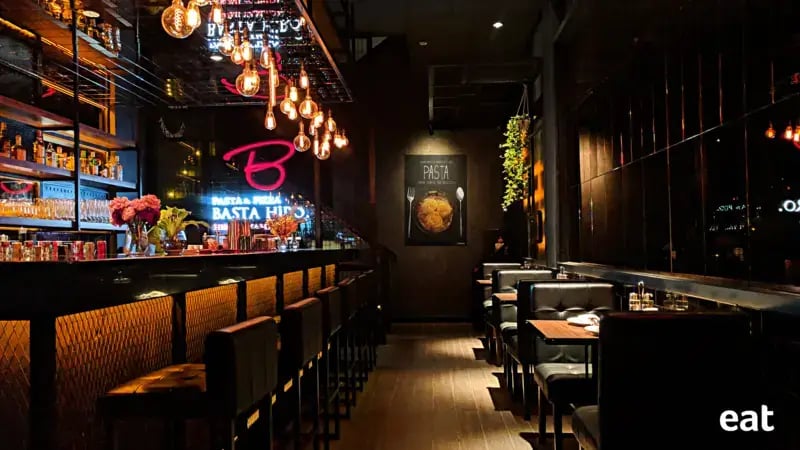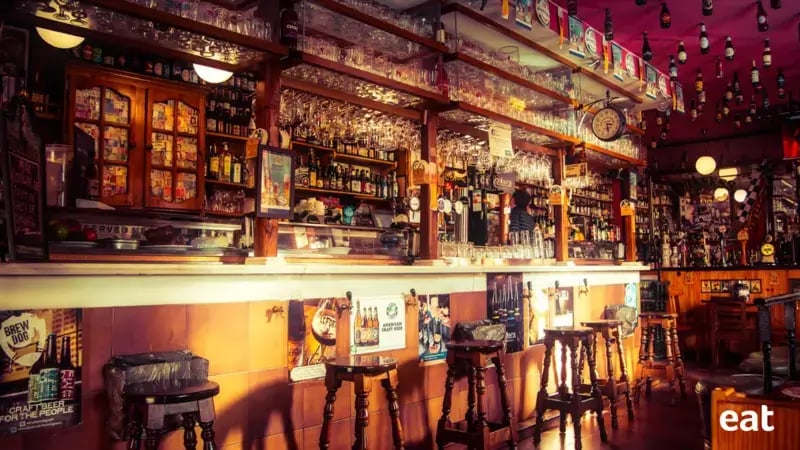Transforming your dream bar into reality takes a lot of planning.
First, come up with the concept for your bar: who are you serving, what's your vibe, and what sets you apart? Create a business plan detailing finances, marketing, and competitor analysis.
Next, secure funding and tackle legalities like licenses and permits. Find a location buzzing with potential customers and matching your vision.
Design a space that reflects your brand and invest in essential equipment and supplies. Recruit and train a skilled team to bring your vision to life.
Stock up on beverages, food (if applicable), and garnishes. Generate excitement through social media, partnerships, and events.
Finally, host a soft opening to iron out kinks before the grand unveiling.
Remember, this is just the roadmap – each step requires research, approvals, and resources. For more on this topic, continue to read our complete guide below
Here's the complete checklist on how to open a bar in 2024:
2. Consider the structure of your business
4. Understand DBA, EIN, and taxes
5. Get the required bar licenses and liquor licenses
7. Organize your marketing, promotion, advertising, and branding
8. Remember to trademark your name and logo
9. Create your bar and begin remodeling
12. Select distributors and suppliers, then buy your supply
13. Create sales forecasts, and pay attention to your bottom line
14. Invest in a table management system
The Complete Checklist to Opening a Bar
1. Create a business plan
Poor initial planning can make fixing a small business like a pub or nightclub expensive, if not impossible. For this reason, before launching a bar or nightclub, bar owners should have a full bar business plan and strategy in place.
You can lower your chance of failure by finding weaknesses in your bar concept and business model that can be addressed before launching by creating a business plan for your bar.
It can also assist you in putting your major objectives—such as your company's competitive advantage and mission statement—into writing.
Plus, it will also help you in estimating the startup expenses you'll incur and in preparing to approach potential investors and investors for funding.
Keep in mind you won't be able to forecast the exact month you finally reach your break-even point, for example. And the exact specifics of your new bar business are likely to vary over time.
What you can do, though, is list the elements and KPIs that will affect the bottom line of your company.
2. Consider the structure of your business
When opening a bar, one of the most important choices you'll have to make is how to set up your company.
Which business structure do you intend to use: corporation, LLC, partnership, or sole proprietorship?
A sole proprietorship or partnership may be simpler to establish, but there is a drawback to this type of organization: you bear personal liability for any debt and/or lawsuits your company incurs.
Stated differently, in the event of a dispute, your liability is unrestricted, which implies that you might have to give up personal belongings to pay for damages.
The most common way to protect yourself from personal responsibility is to incorporate or form an LLC for your restaurant or bar.
These business arrangements restrict your liability by acting as an independent entity and taking on the other business owner's debts.
For example, if someone trips and falls in your bar and wishes to sue, they do so against the business rather than against you.
Make sure you understand what you're committing to before you finalize the complete structure of your business. For more assistance on this topic, we suggest you speak to a bar owner, who can give you some guidance.

3. Get your funding in order
The benefit of bars and nightclubs is that they can more easily make money than restaurants, especially compared to the latter.
Bars can turn a profit faster since alcoholic beverages have high markups and cheap ingredient costs.
They also demand fewer employees, which reduces labor expenses; all of these factors will increase the appeal of your company to possible investors.
Further reading
4. Understand DBA, EIN, and taxes
Taxes are a necessary expense for any organization, and managing this process from the start to the end will save you hassles. The first step is to apply for an Employer Identification Number (EIN), which is the tax ID number for your company, from the IRS.
You must file for a DBA (Doing Business As) if your company will be taxed under a name other than yours or the company's.
A competent accountant is essential to the successful operation of a restaurant business, so it's a good idea to enlist their assistance early on.
Wish I understood DBA and EIN before opening my bar. Tax mess was a nightmare. Hire an accountant—trust me!
5. Get the required bar licenses and liquor licenses
Before you open for business, your bar must have the appropriate liquor license to avoid legal issues and to guarantee the smooth opening and continuing operations of your establishment.
You need a license to sell food and drink in your bar, as well as to play music. While some of these are simple to attain, others need more work.
Starting early is essential because obtaining a bar business license can be expensive and take several days, weeks, or months.
You will likely require legal assistance at some point during the life of your company, so working with a reputable lawyer from the beginning of the opening process will help you steer clear of costly and time-consuming errors.

6. Put together a bar menu
Take inspiration from bar menu design templates, explore local bars, and browse internet menus of bars that share a similar theme. Next, organize and create your own bar menu based on the kind of establishment you're operating.
Further reading
A wine bar should feature a variety of wines, sometimes in a specialty area (like natural wine), while a craft beer bar should have dozens of distinctive, locally brewed beers.
Further reading
A general bar should serve a variety of drinks, including wine, beer, and non-alcoholic options, in addition to classic cocktails and inventive concoctions.

Further reading
7. Organize your marketing, promotion, & branding
Many bars attract guests by word of mouth, foot traffic, and proximity; this is especially true for establishments hoping to establish themselves as beloved local hangouts.
But, it's important to highlight your products with an internet presence and an effective marketing plan to expand your bar business.
This is how you draw in clients from surrounding neighborhoods. Once they enter, your excellent atmosphere and beverage menu will entice them to return, even if it means having to go across town.
Further reading
8. Remember to trademark your name and logo
Register your name and logo with your trademarks with the USPTO, the United States Patent and Trademark Office.
Adhere to the instructions provided on the USPTO website. Keep in mind that in certain situations, you could need legal representation.
Additionally, if you collaborated with a designer to develop your logo, you'll need to work with them to make sure you have the legal authority to use their creations as copyright.
Further reading
9. Create your bar and begin remodeling
Unlike restaurants, where guests can occasionally be content with takeaway or delivery, people go to bars for the ambiance and to mingle.
Likely, people are there for the atmosphere rather than the drink if they are at the bar. That is why it's important to choose the appropriate furniture, décor, and music.
Make sure everything in your bar design complements one another. In one example, everything should be in harmony; don't create a sports bar and play techno music.
Create a board on Pinterest to collect unique ideas for bar decor. Engage the services of an interior designer if you can.
Whatever you choose, be sure to get this right so you can provide your clients with an unforgettable experience and encourage repeat business.

10. Select the ideal spot
The greatest method for locating your bar in the ideal area is to conduct a location study. These are a few of the most important aspects to take into account, while there are many more:
- Target demographics: Either start by focusing on a place whose population characteristics align with your idea or build your whole plan around the characteristics of a chosen site.
- Zoning laws and health regulations: Zoning laws can differ significantly between counties and cities. To ensure you know what to anticipate, make sure you familiarize yourself with the zoning laws in your area.
- Access and visibility: Choosing a spot that is visible to onlookers and drivers alike is crucial. Parking that is accessible is always ideal.
- Take a look at the competition nearby: If there are a lot of bars in the area, you might want to consider choosing an alternative site or making sure your bar has a distinctive concept that makes it stand out.
11. Hire the right people
The staffing requirements of various bar types can differ.
A huge nightclub, for example, will need additional staff, such as a house DJ or bottle service personnel, that a small neighborhood pub won't require.
You might want a sommelier on staff if you manage a wine bar. To start most bars, you'll need to fill the following important positions:
- Bartenders
- A hostess/ host
- A manager
- Bouncer
- Barbacks and servers
Starting a new business and getting in on the ground floor of a new bar excites a lot of potential employees.
Further reading
Creating a clear workplace culture from the start is the greatest approach to retaining your excellent bartending staff given the high turnover rate.
A well-thought-out training program with precise expectations should be developed in addition to conducting interviews and employing new staff.
Ensuring that your staff is properly trained to recognize indicators of obvious intoxication is an essential aspect of owning a bar.
These indicators should be highlighted in your training program, along with advice on how to handle inebriated customers. Ensuring your guests' safety is your duty both during their stay and after they depart from your establishment.
12. Select distributors and suppliers
A method for bar inventory management or appropriate usage of a bar point-of-sale system should be established before opening.
This is because bar inventory plays a significant role in monitoring your cost of sales (including liquor, food, and other critical metrics).
You can determine which drinks are the most profitable in your bar and establish prices with the use of effective bar inventory tracking.
This information can be used to price your bar menu profitably, improve your bar's profit margin, and assist bartenders in making more sensible drink recommendations.
Make sure you have an effective bar accounting system in place in addition to keeping accurate inventory records.
Whether you use Quickbooks or employ a bookkeeper, it's important to monitor your company's performance and identify areas for improvement.
13. Create sales forecasts, and pay attention to your bottom line
Although it can be difficult to project exactly how much money your bar business will make in the first few months, you can start monitoring key performance indicators as soon as you open by utilizing a top-notch bar point-of-sale and reservation system.
Maintain a record of your fixed and variable operational expenses and calculate the daily, weekly, and monthly revenue requirements to meet your expenses, break even, and ultimately turn a successful bar into a profit.
14. Invest in a table management system
The bar scene is competitive, and maximizing efficiency while providing an outstanding guest experience is key to standing out.
A table and reservation system isn't just for fancy restaurants anymore – it's a powerful tool for modern bars to boost revenue, streamline operations, and delight guests.
Here's why:
Enhanced customer experience:
- No more waiting frustration: Offer online reservations to eliminate walk-in wait times and guarantee customers a spot, especially during peak hours. This builds trust and reduces the chance of losing them to competitors.
- Personalized touch: Capture reservation details to offer table preferences, birthday greetings, or special promotions, creating a sense of recognition and appreciation.
- Increased convenience: Integrate with social media platforms or your website for seamless online booking, catering to tech-savvy clientele.
- Reduced queues: Manage bar flow and optimize seating arrangements based on reservations, ensuring smooth service and avoiding overcrowding.
Operational efficiency:
- Maximize table turnover: Allocate tables effectively based on reservation size and duration, leading to more customers served and increased revenue.
- Improved staff communication: Eliminate confusion with a centralized reservation system that staff can access and update in real-time.
- Reduced errors: Minimize double-booking and seating mishaps, leading to better service and happier customers.
- Data-driven decisions: Gain insights into reservation trends and customer preferences to optimize staffing, inventory, and promotions.
Additional benefits:
- Marketing opportunities: Collect customer data for targeted promotions and loyalty programs, fostering repeat business.
- Event management: Facilitate group bookings and special events with dedicated reservation features.
- Reduced no-shows: Implement confirmation systems and require deposits to minimize empty tables and lost revenue.
Choosing the right system:
Consider bar size, budget, and desired features when selecting a system.
Opt for cloud-based options for flexibility and scalability. Invest in a system that integrates with your existing bar POS system for streamlined operations.
15. Purchase bar supplies
The comparatively lower equipment costs at bars compared to restaurants contribute to their greater profitability.
You won't need an industrial mixer, deep fryer, burner, oven, or walk-in freezer if your bar doesn't serve food, which can reduce your startup expenses. It is still possible to work with a more manageable list of essentials if you only serve appetizers or snacks.
If you're creating a sports bar, you will still need to spend money on excellent blenders, lots of refrigerators of all capacities, perhaps a wine cellar, a top-notch dishwasher, a keg and tap system, and lots of TVs.
Find out more about the supplies required to operate a bar, then make a list of what you should acquire first.
For your bar, you'll also need to purchase a tonne of small wares, such as straws, glassware, napkins, and cleaning supplies.
Here are some tips from bar owners on Reddit:
Comment
byu/SirSmilezzz from discussion
inBarOwners

Takeaways
Opening a bar can be an exciting and rewarding journey, but it requires careful planning, dedication, and a touch of passion.
This guide has equipped you with the essential steps to navigate the bar opening process, from crafting your unique concept to securing funding and pouring your first drink.
Remember, the bar industry thrives on innovation and personalized experiences. Don't be afraid to experiment with your menu, create a welcoming atmosphere, and prioritize exceptional customer service.
By staying true to your vision and adapting to market trends, you'll be well on your way to building a thriving bar that becomes a beloved community hub.
FAQ
How profitable is a pub?
What is the typical profit margin at a pub?
Around 80% is the profit margin that most bars strive for.
Bars have an average gross profit margin of almost 75% overall. Being able to measure and regulate your pour expenses is essential to hitting that target. Pour cost is an important metric to measure the profitability of your bar.
What is the startup cost of a local pub?
A pub must spend between $110,000 and $850,000 to be fully operational when it is first opened, for an average of $480,000.
Taking over an established pub business is typically less expensive because you'll save money on renovations and can include furnishings and equipment in the deal.
Are bars considered a good investment?
Purchasing a pub places owners in a sector of the economy that has the potential to grow for many years, but the companies with the most innovative approaches to customer service will probably have the advantage in this regard.
Customers of today anticipate quick service and prompt fulfillment of their wants when they visit bars because they are accustomed to it.














.webp?width=200&name=v2-15mknc-qpw1b%20(1).webp)
.webp?width=200&name=v2-15kqni-p0exl%20(1).webp)
-1.png?width=1812&height=1072&name=TripAdvisor%20%26%20More%20Bookings%20(1)-1.png)
-2.png?width=1812&height=1072&name=Google%20Bookings%20(1)-2.png)


-1.png?width=200&name=TripAdvisor%20%26%20More%20Bookings%20(1)-1.png)
-2.png?width=200&name=Google%20Bookings%20(1)-2.png)
-1.png?width=200&name=Instagram%20Bookings%20(1)-1.png)
-1-png.webp?width=200&name=Facebook%20Integration%20Rectangle%20(1)-1-png.webp)







.webp?width=200&name=download%20(1).webp)
%20(1)-2.webp?width=200&name=Eat%20(34)%20(1)-2.webp)
%20(1)-2.webp?width=200&name=Eat%20(18)%20(1)-2.webp)













%20(1)-1.webp?width=314&height=175&name=Eat%20(62)%20(1)-1.webp)


.webp?width=144&height=72&name=Eat%20App%20Logo%20(3).webp)